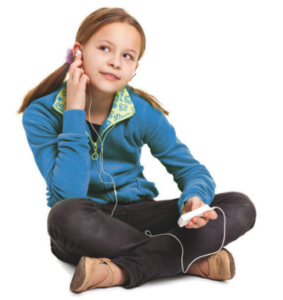A strange phenomenon occurred when my son turned 11 years old. He turned up the volume on his mp3 player and turned down the volume on me. Okay, maybe it wasn’t so strange. But the look he gave me when I told him he had to turn down the music because it would damage his hearing did surprise me. “What? You gotta be kidding?” he snapped. “But everyone else is doing it!”
According to the Hearing Loss Association of America, millions of Americans suffer from hearing loss, including children younger than 18 with a diagnosed hearing loss who are not now using a hearing aid. Hearing loss in teens often goes unnoticed. That is, until it is too late. But the problem can be prevented.
The main cause of hearing loss in young people today includes loud noises such as mp3 players plugged into their ears and rock concerts. Add to that noisy city streets, deafening lawn mowers, blaring televisions, and high-pitched hair dryers, and you have an equation for permanent hearing loss.
According to health professionals, the occasional blast of a horn or siren does not do the damage. Rather, the culprit lies in the constant exposure to loud noises. Noise is measured in decibels. A normal conversation measures about 60 decibels. A lawn mower rates at 90 decibels and amplified rock music, between 110 and 130 decibels. Prolonged exposure to sounds above 85 decibels can cause hearing loss. The definition of prolonged depends on the decibel level. For example, the lawn mower can cause hearing damage after eight hours of exposure per day. With rock music, damage occurs somewhere between 4 and 30 minutes of exposure per day.
What can parents do?
Prevention is the key. Set guidelines on your teen’s listening habits to protect his ears. If your child is in his room listening to his stereo, decide how loud the music may be. A good measure involves not having to shout to be heard above the music. Hearing distortion, ringing, buzzing or roaring sounds after leaving a noisy environment are signs the music is too loud.
If your teen listens to music with headphones, take extra precaution. Concentrated sounds coming from headsets are more likely to damage your child’s hearing than just listening to music in a room. When music is played in a room, much of its surroundings—carpet, furniture, walls—absorb the sound. With headphones, the frequencies go directly to the ears.
Stand in the same room with your teen while he is listening to his headset. If you can hear the song being played, the music is too loud. To establish a code of conduct, set the volume at a reasonable level, and insist your teen keep it there. If necessary, mark the volume with a permanent marker. Be consistent—the rules must be obeyed or the privilege lost.
What about live music?
When in an environment with live music, insist that your child wear earplugs. There are several different types of plugs on the market, from disposable foam to reusable rubber ones that if worn correctly, will provide adequate protection. Music stores often carry special earplugs that filter out harmful frequencies but keep the sound from distorting.
Audiologists can, for a price, custom design earplugs for your child’s ears. Devices such as cotton balls, tissues and napkins offer no protection. While they do muffle sounds, the frequencies travel right through the cotton. No, earplugs may not be “cool” and you may be faced with much opposition, but again, it is setting the rules of acceptance for the privilege.
Teen’s should have their hearing checked once a year, and parents should relay to the audiologist what kind of noise their child has been exposed to so he can perform the test accordingly.
And finally, if your young person gives you a hard time about these newfound rules, direct him to the website Hearnet, www.hearnet.com, a site for hearing education and awareness for rockers. You are, after all, the parent, and protecting your child is still your responsibility.





